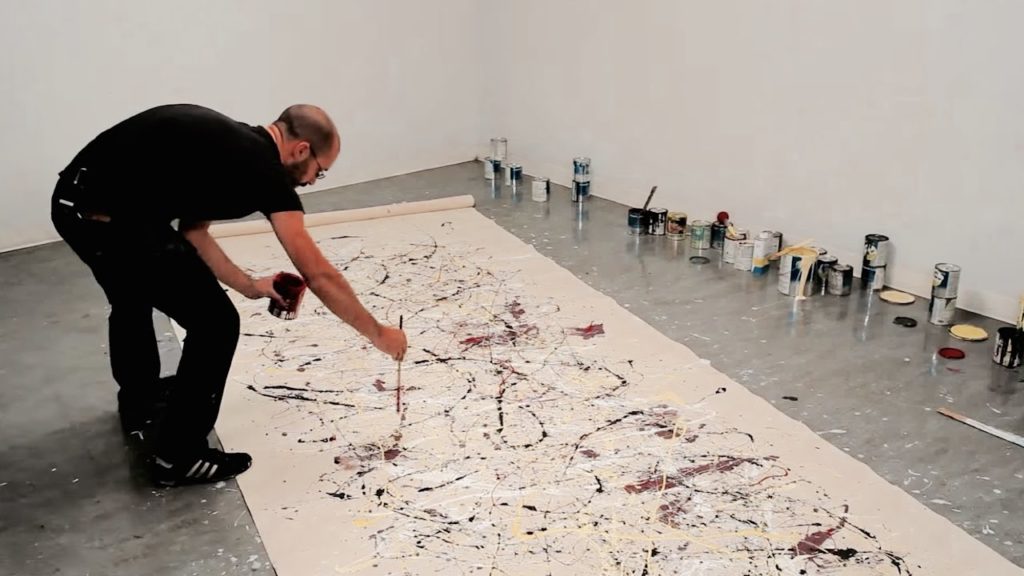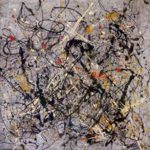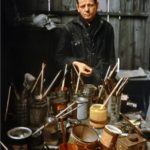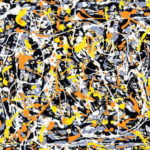Painter, printmaker, and occasional sculptor. The iconic abstract expressionist, he forged a singular style of great expressive power. Skeins of dripped, poured, and flung paint dominate his key all-over paintings of the late 1940s and early 1950s.
Using gestural motions while working over canvases spread on the floor, he created an untrammeled poetry that resonated with American traditions of individuality, grandiloquence, and ambition. His work meshed as well with the psychic bent of postwar society, reflecting fear of chaos and destruction as well as its opposite: hope for a world made new. Although often criticized for its supposed lack of skill, his technique required much discipline and creative control. Among imitators, no one came close to matching his achievement. Since his early and violent death, Pollock has also come to embody the myth of the tragic hero, tortured by the spiritual and psychic forces responsible for his art. However romanticized this view may be, he undeniably experienced much inner turmoil. An alcoholic troubled by lifelong insecurities about personal worth, sexuality, and human relationships, he believed that art came from the unconscious.

Apparently his creative process provided some relief from psychic tensions. At the same time, the work itself and its critical reception provoked additional anxieties, as he suffered doubts about the value of his art and worried about his professional reputation. Pollock’s inmost thoughts remain obscure, as he left few letters or other written records. He produced virtually all of his important work in a single decade, the period from his early thirties into his early forties. Nearly all the celebrated all-over canvases date from only four years, 1947 through 1950. A fallow period of some eighteen months, during which he hardly painted, preceded his death in an automobile accident. He was behind the wheel, drunk, and possibly suicidal.
 Paul Jackson Pollock was born in Cody, Wyoming, but his impecunious farming and ranching family left there before he was a year old. During his youth, they moved nine times among various Arizona and California locations. Unlike many well-known artists, as a child Pollock showed little interest in drawing. Although passably well read as an adult, suspensions and expulsions marred his high school years, and he did not graduate. At the last school he attended, Manual Arts High School in Los Angeles, a teacher stimulated his interest in art and in philosophy. In particular, theosophical teachings that encouraged self-discovery made an important impression. There, too, he became a close friend of Philip Guston. About the time he moved to New York in September 1930, he dropped the first name of Paul. He enrolled at the Art Students League, where his mentor Thomas Hart Benton imbued his pupil with antimodern prejudices, with his belief in the need to root art in native experience, and with his admiration for dynamic and muscular stylization, particularly as realized on the heroic scale of murals. Within a few years of leaving the league early in 1933, Pollock shed his antipathy for modern art, but aspects of Benton’s teaching remained permanently relevant to Pollock’s thinking. In the mid-1930s Pollock also admired the Mexican mural painters, particularly David Alfaro Siquieros. His experimental workshop, which Pollock attended in 1936, stimulated interest in unorthodox techniques. As well, he was drawn to the work of Albert Pinkham Ryder. Pollock’s paintings of the 1930s generally offer rhythmic interpretations of imaginary western scenes, often dark-toned and mysterious.
Paul Jackson Pollock was born in Cody, Wyoming, but his impecunious farming and ranching family left there before he was a year old. During his youth, they moved nine times among various Arizona and California locations. Unlike many well-known artists, as a child Pollock showed little interest in drawing. Although passably well read as an adult, suspensions and expulsions marred his high school years, and he did not graduate. At the last school he attended, Manual Arts High School in Los Angeles, a teacher stimulated his interest in art and in philosophy. In particular, theosophical teachings that encouraged self-discovery made an important impression. There, too, he became a close friend of Philip Guston. About the time he moved to New York in September 1930, he dropped the first name of Paul. He enrolled at the Art Students League, where his mentor Thomas Hart Benton imbued his pupil with antimodern prejudices, with his belief in the need to root art in native experience, and with his admiration for dynamic and muscular stylization, particularly as realized on the heroic scale of murals. Within a few years of leaving the league early in 1933, Pollock shed his antipathy for modern art, but aspects of Benton’s teaching remained permanently relevant to Pollock’s thinking. In the mid-1930s Pollock also admired the Mexican mural painters, particularly David Alfaro Siquieros. His experimental workshop, which Pollock attended in 1936, stimulated interest in unorthodox techniques. As well, he was drawn to the work of Albert Pinkham Ryder. Pollock’s paintings of the 1930s generally offer rhythmic interpretations of imaginary western scenes, often dark-toned and mysterious.
 From August 1935 until 1942, Pollock was employed most of the time by a federal art project. After a brief stint with the murals program, he worked subsequently as an easel painter. However, the strains of poverty and fear of failure as an artist exacerbated an alcoholic tendency that had been a problem since he was about fifteen. In 1937 he first sought treatment, and following a breakdown the following year, he was hospitalized for several months. From 1939 through 1941, he worked successively with two Jungian analysts who assisted his emergence as an individualistic creative personality. As part of his therapy, he produced drawings in which he reoriented his interests toward aspects of the period’s fascination with primitivism and surrealism. Among models of accomplishment, Picasso and Mexican muralist José Clemente Orozco took on particularly important roles. At a deeper level, Pollock began to understand that both his art and his self-preservation depended upon his ability to transform psychic forces into aesthetically valid statements. Around 1940 John Graham took on an important role in leading Pollock toward a more sophisticated understanding of New York’s artistic milieu. Further, by inviting both to participate in an important January 1942 gallery show, he also was indirectly responsible for initiating the relationship between Pollock and Lee Krasner. Better trained, more accomplished as an artist, more intellectually trenchant, and better acquainted among the people who counted in the New York art world, Krasner intuited Pollock’s potential greatness and undertook to shape his success. Perhaps even most important than her professional encouragement and the order she brought to his life, Krasner offered Pollock, probably for the first time in his life, a stable emotional relationship. Theirs was not an easy partnership, but it provided essential nurturance for the artistic achievements of both, although Krasner’s were largely deferred. In their years together, she put his career first. They started living together in late summer 1942 and were married in October 1945. The influence of Graham and Krasner was augmented in the early 1940s by new contacts with surrealist-oriented artists, including William Baziotes and Gerome Kamrowski, but most notably Roberto Matta. He encouraged Pollock to experiment with automatist techniques, to incorporate accidental effects in his art, and to pursue risky aesthetic strategies. Miró’s 1941–42 retrospective at the Museum of Modern Art reinforced such tendencies. From 1942 Peggy Guggenheim‘s interest in Pollock’s work allowed him to relinquish the odd jobs that had been his support and to concentrate more fully on his painting. He staged his first one-person show at her gallery, Art of This Century, in 1943 and exhibited there twice more before the gallery closed in 1947.
From August 1935 until 1942, Pollock was employed most of the time by a federal art project. After a brief stint with the murals program, he worked subsequently as an easel painter. However, the strains of poverty and fear of failure as an artist exacerbated an alcoholic tendency that had been a problem since he was about fifteen. In 1937 he first sought treatment, and following a breakdown the following year, he was hospitalized for several months. From 1939 through 1941, he worked successively with two Jungian analysts who assisted his emergence as an individualistic creative personality. As part of his therapy, he produced drawings in which he reoriented his interests toward aspects of the period’s fascination with primitivism and surrealism. Among models of accomplishment, Picasso and Mexican muralist José Clemente Orozco took on particularly important roles. At a deeper level, Pollock began to understand that both his art and his self-preservation depended upon his ability to transform psychic forces into aesthetically valid statements. Around 1940 John Graham took on an important role in leading Pollock toward a more sophisticated understanding of New York’s artistic milieu. Further, by inviting both to participate in an important January 1942 gallery show, he also was indirectly responsible for initiating the relationship between Pollock and Lee Krasner. Better trained, more accomplished as an artist, more intellectually trenchant, and better acquainted among the people who counted in the New York art world, Krasner intuited Pollock’s potential greatness and undertook to shape his success. Perhaps even most important than her professional encouragement and the order she brought to his life, Krasner offered Pollock, probably for the first time in his life, a stable emotional relationship. Theirs was not an easy partnership, but it provided essential nurturance for the artistic achievements of both, although Krasner’s were largely deferred. In their years together, she put his career first. They started living together in late summer 1942 and were married in October 1945. The influence of Graham and Krasner was augmented in the early 1940s by new contacts with surrealist-oriented artists, including William Baziotes and Gerome Kamrowski, but most notably Roberto Matta. He encouraged Pollock to experiment with automatist techniques, to incorporate accidental effects in his art, and to pursue risky aesthetic strategies. Miró’s 1941–42 retrospective at the Museum of Modern Art reinforced such tendencies. From 1942 Peggy Guggenheim‘s interest in Pollock’s work allowed him to relinquish the odd jobs that had been his support and to concentrate more fully on his painting. He staged his first one-person show at her gallery, Art of This Century, in 1943 and exhibited there twice more before the gallery closed in 1947.
Characteristic paintings of the early 1940s incorporate within heavily painted, pulsing compositions representational fragments derived from primitivizing or mythic sources. Passages of splattered and dribbled paint in some of these works prefigure the gestural technique he fully embraced a few years later. Male and Female (Philadelphia Museum, c. 1942), Guardians of the Secret (San Francisco Museum of Modern Art, 1943), and The She-Wolf (Museum of Modern Art, 1943) numbered among such paintings included in his first solo show. Their audacious novelty startled the art public, and MoMA confirmed his stature as an important artist when it purchased The She-Wolf the following year. Even before this first Pollock painting entered a public collection, the artist had produced a work that surpassed anything he had achieved to date and forecast the all-over paintings yet to come. For the entrance hall of Guggenheim’s apartment, Pollock painted the breakthrough Mural (University of Iowa Museum of Art, Iowa City, 1943–44; dated 1943), an internationally unprecedented work. Its twenty-foot length, covered with vigorous paint swirls that vaguely suggest a procession of abstracted figures, demands a new kind of relationship with the viewer it practically engulfs, especially when viewed as intended within a relatively shallow space. Its scale, aggressively interlocked solids and voids, muscular physicality, and crude assault on the intellect register with force even today. In the mid-1940s Pollock followed this achievement with densely painted works that gradually obliterate imagery, as exemplified by Eyes in the Heat (Peggy Guggenheim Collection, Venice, 1946), which retains only reminiscences of ocular forms embedded in the swirling materiality of paint. Despite Pollock’s creative achievement, sales were few. Self-criticism tore at his fragile ego, in a familiar pattern that he relieved with drink.
 To escape the milieu that exacerbated his alcoholism, a couple of weeks after their marriage, Pollock and Krasner moved to Springs, a village within the town of East Hampton, on the eastern end of Long Island. There, in relative isolation from day-to-day art-world pressures, Pollock reconnected with nature as he had not since leaving the West. Over the next year and a half, his painting lost its haggard belligerency to more relaxed and expansive rhythms, realized on a large scale. Imagery gradually evaporated as manipulation of paint became central. His direction at this point probably benefited from the emphasis on process, linear freedom, and intuition at Atelier 17, which he had frequented in 1944. In 1947 he embarked on the all-over drip paintings that permanently sealed his reputation as a giant of twentieth-century art. Endeavoring to escape the limitations of brushwork, he applied thinned paints by pouring directly from a can or flinging the liquid from the end of a stick. Because they are less viscous than oil, he often used enamels and metallic paints, and he sometimes added texture by embedding sand or other non-art materials in the paint. Pollock’s working process famously required complete psychic and physical involvement, as he seemed to dance his paintings into being. Often, at various stages in the process, Pollock put the canvases aside, sometimes for long consideration, before initiating the next working session. In a well-known 1947 statement for Possibilities , Pollock explained that tacking the canvas to the floor allowed him to work on it from all four sides, to “literally be in the painting,” a process that he likened to Indian sand painting. He further explained, “When I am in my painting I’m not aware of what I’m doing. It is only after a sort of ‘get acquainted’ period that I see what I have been about.”
To escape the milieu that exacerbated his alcoholism, a couple of weeks after their marriage, Pollock and Krasner moved to Springs, a village within the town of East Hampton, on the eastern end of Long Island. There, in relative isolation from day-to-day art-world pressures, Pollock reconnected with nature as he had not since leaving the West. Over the next year and a half, his painting lost its haggard belligerency to more relaxed and expansive rhythms, realized on a large scale. Imagery gradually evaporated as manipulation of paint became central. His direction at this point probably benefited from the emphasis on process, linear freedom, and intuition at Atelier 17, which he had frequented in 1944. In 1947 he embarked on the all-over drip paintings that permanently sealed his reputation as a giant of twentieth-century art. Endeavoring to escape the limitations of brushwork, he applied thinned paints by pouring directly from a can or flinging the liquid from the end of a stick. Because they are less viscous than oil, he often used enamels and metallic paints, and he sometimes added texture by embedding sand or other non-art materials in the paint. Pollock’s working process famously required complete psychic and physical involvement, as he seemed to dance his paintings into being. Often, at various stages in the process, Pollock put the canvases aside, sometimes for long consideration, before initiating the next working session. In a well-known 1947 statement for Possibilities , Pollock explained that tacking the canvas to the floor allowed him to work on it from all four sides, to “literally be in the painting,” a process that he likened to Indian sand painting. He further explained, “When I am in my painting I’m not aware of what I’m doing. It is only after a sort of ‘get acquainted’ period that I see what I have been about.”
In their public introduction at the Betty Parsons Gallery in January 1948, the first group of signature paintings included such completely realized achievements as Cathedral (Dallas Museum of Art, 1947) and Full Fathom Five (Museum of Modern Art, 1947). The previous fall Clement Greenberg had already deemed Pollock “the most powerful painter in contemporary America and the only one who promises to be a major one,” and generally favorable critical opinion greeted the show. In the fall of 1948, Pollock began successful alcoholism treatment with a Long Island doctor. During the following two productive years, with the appearance of such masterpieces as Number 1, 1950 (Lavender Mist) (National Gallery, 1950) and Autumn Rhythm (Number 30) (Metropolitan Museum, 1950), his reputation soared. In July 1950, Pollock met Hans Namuth (1915–90), a photographer becoming particularly known for insightful portraits of artists and other cultural figures. Pollock agreed to allow Namuth to photograph and film him at work. At the conclusion of the final session, held outdoors on a chilly late November afternoon, Pollock had his first drink in two years. His doctor had died some months previously, the artist had become a public figure although sales of his work were few, and performing for the camera may have been a stressful violation of his private relationship with his art. Moreover, his annual Parsons Gallery show was about to open, revealing to the public his finest and most ambitious work to date. Much was at stake. One drink led to too many, and before the evening was over he had staged a drunken scene before guests. Although important paintings followed, he never regained his equilibrium. Bouts of depression that he could relieve only with alcohol became increasingly common.
Unwilling to repeat himself by turning out additional works of the type now associated with his name, in 1951 he abandoned the format that had made him famous. Returning to fragmented imagery, he limited his means to black enamel on unprimed canvas. These paintings debuted to muted reception late that year in his last show at Parsons. In subsequent work, which appeared in three shows at the Sidney Janis Gallery, he sought renewal through erratic extension or synthesis of previous tendencies. His limited work from 1952–53 includes canvases featuring imagery as well as completely abstract works, some painted, some poured. More than eleven feet wide, the evocative but unresolved Portrait and a Dream (Dallas Museum of Art, 1953) pointed to the artist’s current dilemma. A colorful, semi-abstract, conventionally executed head on the right of the horizontal composition confronts a black, poured “dream” of intricate linearism suggesting the form of a woman. Yet, the same period produced the masterful abstraction, Blue Poles: Number 11 (National Gallery of Australia, Canberra, 1952), a frenzied symphony of tangled hues organized around eight dark blue voids or “poles.”
In 1954 he painted relatively few works, though the dense White Light (Museum of Modern Art, 1954) demonstrates continued power. Nevertheless, by early 1955, he had reached a creative impasse. Depressed, he perhaps questioned his own worth but, feeling that his art had been misunderstood, insisted that it had not received the recognition it deserved. Perhaps in defiance of his own best interests, which had always benefited from creative activity, he more or less stopped painting. On an August night the next year, only a few hundred yards along Fireplace Road from his home and studio, he ran his convertible off the road, catapulted from the car when it flipped over, collided with a tree, and died instantly. In his last months, he knew that he had achieved a measure of success among art-world elite, but he also felt that popular culture generally represented him as an artistic fraud. Not long before his death, Time magazine nailed him as “Jack the Dripper.” He could not have known that his work would forever change what it means to be a painter, that within a few years his paintings would sell for prices unmatched by those of any American artist, and that he would be in large part responsible for relocating the art world’s center of gravity from Paris to New York. The house and studio where Pollock and Krasner lived and worked in Springs have been preserved as the Pollock-Krasner House and Study Center, administered by the Stony Brook Foundation under the aegis of the State University of New York at Stony Brook.
Two brothers also became artists, though neither came close to matching Jackson’s talent or reputation. Born in Denver, Charles Cecil Pollock (1902–88) was a painter and lithographer. At the end of 1921 he quit high school to move to Los Angeles, where he studied at the Otis Art Institute (now Otis College of Art and Design). He soon began regularly sending The Dial and art magazines home, where they intrigued and inspired his younger brothers. Continuing to embody for them the romance of the art life, in 1926 he moved to New York. He studied with Benton at the Art Students League, paving the way there for Jackson. In 1935 he relocated to Washington, D.C., to work for the Resettlement Administration but after less than two years moved on to Detroit, where he served as a federal art administrator until 1942. He then taught at Michigan State University in East Lansing until the mid-1960s. Within a few years, he moved permanently to Paris but continued to exhibit in New York. His early work reflects the regionalist interests of the time, while from the 1940s onward he produced abstractions. To escape Jackson’s shadow, in the 1940s he showed his work in New York under the name Charles Pima. The family member emotionally closest to Jackson, as well as the closest in age, painter and printmaker Sanford McCoy (1909–63), known as Sande (or Sandy), worked in the early 1930s with Siqueiros in Los Angeles, where Jackson’s friends Guston and Chicago-born surrealist painter and printmaker Reuben Kadish (1913–92) also assisted his development. (Kadish moved east in the mid-1940s, worked as an abstract expressionist, later took up sculpture, and taught at Cooper Union from 1960 until a few months before his death in Manhattan.) In 1935, the year after he arrived in New York, Sande changed his surname to McCoy, his father’s birth name. (The father’s name had been changed to Pollock when he was adopted at an early age.) With Jackson, he found work with a federal art project and resumed contact with Siquieros at the New York workshop. In 1942 he moved permanently to Deep River, Connecticut. He later ran a print shop in nearby Essex. He died of leukemia in a Boston hospital.
